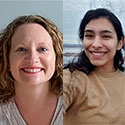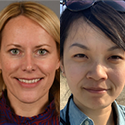Hot Off the Press – April 5, 2022 Published in Molecular Psychiatry by Stephanie Carmack and Leandro Vendruscolo et, al. of the NIDA IRP Neurobiology of Addiction Section. Summary The sharp increase in opioid overdose-related deaths in the United States is a public health emergency. An urgent search to uncover the biological mechanisms of opioid… [Read More]
Hot off the Press
Involvement of the ghrelin system in the maintenance of oxycodone self-administration: converging evidence from endocrine, pharmacologic and transgenic approaches
Hot Off the Press – February 7, 2022 Published in Molecular Psychiatry by Zhi-Bing You and Lorenzo Leggio et, al. at NIDA IRP. Ghrelin, an orexigenic hormone, has recently emerged as a critical biological substrate implicated in drug reward. However, the reciprocal interactions between the endogenous ghrelin system and drug-motivated behaviors remain to be understood…. [Read More]
Detailed mapping of behavior reveals the formation of prelimbic neural ensembles across operant learning
Hot Off the Press – January 3, 2022 Published in Neuron by Yan Zhang, Alex Denman, and Da-Ting Lin, et al. of the NIDA IRP Neural Engineering Section. Zhang and Denman et al developed deep behavior mapping (DBM), a self-supervised learning method for fine-grained analysis of behavioral micro-states in video data. They combined DBM with… [Read More]
Waving through the window: a model of volitional social interaction in female mice
Hot Off the Press – December 21, 2021 Published in Biological Psychiatry by Leslie Ramsey, et al. In this study we introduce a model of volitional social learning and choice in female mice. We systematically compare two widely used mouse strains at two different developmental stages: adolescent and adult C57BL/6 mice and outbred CD1 mice. Unexpectedly,… [Read More]
Orbitofrontal cortex and dorsal striatum functional connectivity predicts incubation of opioid craving after voluntary abstinence
Hot Off the Press – November 5, 2021 We recently introduced a rat model of incubation (time-dependent increase) of oxycodone craving after voluntary abstinence induced by negative consequences of drug seeking. We used resting-state functional MRI to determine whether longitudinal functional connectivity changes in orbitofrontal cortex (OFC) circuits would predict incubation of oxycodone seeking after… [Read More]
Sex differences in the effect of chronic delivery of the buprenorphine analog BU08028 on heroin relapse and choice in a rat model of opioid maintenance
Hot Off the Press – October 12, 2021 Previous studies reported that the NOP/µ receptor partial agonist BU08028 produced antinociception in rodents and non-human primates and is not self-administered by non-human primates, leading to the suggestion that BU08028 can be a promising candidate for opioid addiction treatment. In a buprenorphine-validated rat model of opioid agonist… [Read More]
The protective effect of operant social reward on cocaine self-administration, choice, and relapse is dependent on delay and effort for the social reward
Hot Off the Press – August 24, 2021 In humans who use addictive drugs, social-reinforcement-based treatments can protect against drug use and relapse, but not in all patients. We used a new operant rat model that mimics features of one such treatment, the community-reinforcement approach; having previously shown that rats choose social reinforcement over heroin… [Read More]
Inactivation of the infralimbic cortex decreases discriminative stimulus-controlled relapse to cocaine seeking in rats
Hot Off the Press – July 7, 2021 Published in Neuropsychopharmacology by Rajtarun Madangopal and Bruce Hope, et al. in the NIDA IRP Neuronal Ensembles in Drug Addiction Section. Discriminative stimuli (DSs) play an important and understudied role in the persistent susceptibility to drug relapse. They signal drug availability (DS+) or unavailability (DS-) and control… [Read More]
An excitatory lateral hypothalamic circuit orchestrating pain behaviors in mice
Hot Off the Press – June 7, 2021 Published in eLife by Justin Siemian and Yeka Aponte, et al. in the NIDA IRP Neuronal Circuits and Behavior Unit. Decades of work have revealed the lateral hypothalamus (LH) as a crucial region for orchestrating appetitive and reward-related behaviors. However, the contributions of genetically-identified lateral hypothalamic neurons to other… [Read More]
A target-agnostic screen identifies approved drugs to stabilize the endoplasmic reticulum-resident proteome
Hot Off the Press – April 30, 2021 Published in Cell Reports by Mark Henderson and Kathleen Trychta, et al. In the paper by Henderson et al., we developed a high throughput screen to identify molecules that can stabilize protein homeostasis inside of cells (brain, muscle, liver, etc) during pathological states. The screen was based… [Read More]










